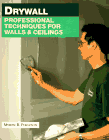DRYWALL-Hanging
Plan the layout of your project to use full sheets whenever possible and make the cuts so that the joints fall in the center of a joist or stud. Hang ceilings first.
Measure and mark your panels with the light colored face paper towards you.
Line up your straight edge or "T" square with
the marks and press firmly against the panel.
Score through the paper and lightly into the core with your knife. Now break the panel core by grasping the panel edges near the score line and break the board by pushing the ends away from you in the directionof the uncut side. You can also just push one end away from you while holding the other end firmly in place. Now use your knife to cut through the back paper for the length of the cut.
After cutting the panel,place your knee on the board over the cut and with a quick snap pull the two ends towards you,the board will snap clean. Smooth the cut edge with sandpaper or a surefoam rasp.
Keep the edges as square as possible.
For openings such as an electrical outlet, measure the near, far,top and bottom sides of the box to the nearest edges of the wallboard and trace the outline at the appropriate position on the wallboard. Then cut the opening with a saber saw or keyhole saw or plunge-type router.
Cutting Circles: you can use a special "circle cutting" tool but if you don't want to invest in something you will probably never use again, simply take a bowl or can, anything round that is the same size as the circle you need, trace the pattern onto the board and use your utility knife to score the board around the line. Cut thru with your utility knife or use a keyhole saw.
Attaching or Hanging Drywall:
Prior to drywall attachment inspect framing to ensure that it is straight and free of nails or other projections. Warped or crooked framing should be repaired or replaced.
For best results, remember to always stagger the end (butt) joints like brick is laid with offset end seams. This will help avoid cracking.
You should hang your ceilings first so the walls can help support the ceiling sheets.
Mark the joist locations along the wall top plates so they are easy to find once
covered. Use screws for best results. They provide more holding power than drywall
nails. Usually it is best to run the panels perpendicular
to the joists. Also applying construction adhesive to the
joist will help provide a better hold.
Hold your panel tight against your framing and with your screwgun,screw the center of the panel first and the perimeter last. If you are nailing instead of using screws, it's wise to invest in a specially designed drywall hammer. The head is shaped so that it creates a perfect dimple while setting the nail. You may want to get a couple strong helpers to maneuver the panels overhead or use T-braces.
Make sure the screw or nail heads are driven to create a small dimple but without breaking or tearing the paper face. If you drive a nail crooked or bend it over don't try to pull it out. Drive a second nail about 2" away then make sure that first nail is driven in below the panel surface. Space nails a maximum of 7" apart on ceilings and 8" apart on walls. Space screws a maximum of 12" apart on ceilings and 16" apart on walls.
Next you can hang the walls.
Hang the drywall horizontally and remember to stagger the butt joints. Install that top row first. Position it tight against the ceiling panel and fasten it to the studs in the same way as was described for ceilings. Again, using construction adhesive will be helpful. Then install the lower panels so that the tapered edge meets with the tapered edge of the upper panels. Do any necessary trimming on the edge nearest the floor only.
Avoid vertical joints directly above or below door or window openings whenever possible.
Apply corner bead,available in either plastic or metal,to all outside corners of walls, soffits, and window returns. Hold the bead firmly against the corner and try to maintain the 90-degree angle. Nail it through the existing holes located every 9" on each flange. Be sure that the nails hit studs. Plastic bead can be fastened with staples. Drive all nails to below the nose of the bead being careful not to dent the metal.
Nails VS. Screws
Overall, screws are generally the preferred fasteners because they hold into the framing better. The job will also go faster if you have the right kind of screw gun. You want an adjustable gun that will almost automatically sink the screw a little below the surface whenproperly adjusted. You can use a regular hand drill or screw gun but you must control the depth yourself. Sears sells a nifty bit for use with a regular drill that countersinks the screw perfectly.
Drywall nails (1 ¼" ring shank for ½" thick drywall) are often easier for a person who is not comfortable with a screw gun. The job will be a bit slower and you will need to use more nails (closer together) because they are not as strong as screws. Remember prying out a bent nail may cause more damage than nailing it in so that it is below the surface and then mudding over it later.
Back to top
|
Drywall all About
Patching
Hanging-
Tools and Preparation
Hanging-
Procedure
( You are here )
Finishing-
Tools and preparation
Finishing Procedure-
Start to Finish
Texturing Large areas
Texture Patches
See What's


Insulating Paint
For Roofs
Mobile Homes
Ceilings , Walls
Animal Shelters
If you Can Paint It
We Can Insulate It !
This paperback book contains drywall basics, the tools and materials you will need, and hanging and taping.
Has numerous black and white photographs and helpful illustrations. Repairing drywall, and how to apply special textured finishes.

|


